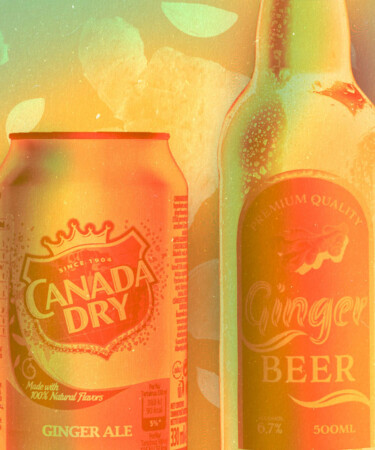Ginger ale and ginger beer are different branches from the same root. While the former is more well-known than the latter thanks to the ubiquity of household-friendly brands like Canada Dry, their zesty profiles make both handy ingredients at bars nationwide, where they’re chiefly used as non-alcoholic mixers.
While the two beverages share a ginger-fueled flavor note, they are distinctively different and should not be treated interchangeably. Doing so can run the risk of downgrading a drink from great to average or, even worse, creating an unbalanced mixed beverage. When bartenders keep ginger ale and ginger beer in their appropriate lanes, however, the results can be magical. To learn more about how to use the two ingredients effectively, VinePair spoke with Laura Newman, the 2018 U.S. Bartender’s Guild World Class Bartender of the Year and owner/beverage director of Queen’s Park and Neon Moon in Birmingham, Ala.
“It’s a matter of intensity,” Newman explains. “Ginger beer is spicier than ginger ale — not spicier like it gives off a lot of heat, but spicier in that it contains this aggressive element that creates more intense flavor extraction. Ginger ale is usually a little sweeter and can approximate that ginger flavor, but without that level of spice.”
The variance in flavor concentration is key to the ginger-based drinks’ respective usage. Newman says ginger beer’s elevated intensity allows it to stand up in high-proof spirits and work with boozier drinks. It can also withstand dilution better, making it an ideal choice for Collins drinks with crushed ice. Ginger ale, on the other hand, works better in drinks with delicate flavors. Straying from this framework can have unfortunate consequences.
“Using the wrong one can throw a cocktail off balance,” Newman says. “A perfect example of this is a Chilcano. The recipe calls for pisco, lime, bitters, and ginger ale. If you replace the ginger ale with ginger beer, it’s going to overpower the other ingredients.”
Even when the right ginger soda is used, it’s important to be completely dialed into drink ratios, as being even a little off-target could overwhelm other drink ingredients, like citrus. “When you’re using ginger ale in a drink, you need to think about its added sugar,” Newman explains. “Putting too much of it in a cocktail will knock it out of balance because of its sweetness.”
For home bartenders, the type of spirit in the cocktail should be taken into consideration, especially if it’s is nicer than the one usually hanging around in the service well at their neighborhood spots. “Use ginger beer with an entry-level spirit,” Newman says. “If you’re using something nicer that’s super complex and delicate, you want to experience the more flavorful elements that it may bring to a drink. Ginger beer’s intensity will cover those notes. If you’re going to still use ginger beer, dial it back a little or maybe mix it with water.”
Newman acknowledges that most Americans are more accustomed to the taste of ginger ale and believes it makes sense for most people to stick with what they know for home cocktails if they must choose between the two. Still, she encourages more adventurous home bartenders to play around with both flavor profiles. “It can be cool to have ginger ale and ginger beer in your home bar if you can afford it,” she says. “It’s really the ideal way to go if you really want to nerd out.”
